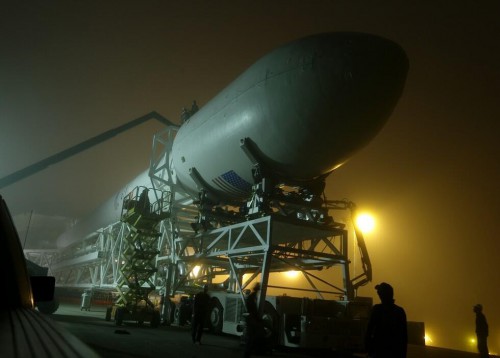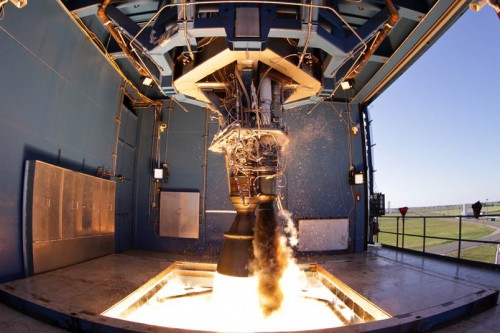
With a launch record that has so far carried it no higher than low-Earth orbit, SpaceX plans a figurative and literal leap in altitude this week with Monday night’s liftoff of its two-stage Falcon 9 v1.1 rocket, carrying the SES-8 geostationary communications satellite for SES World Skies to provide bandwidth-growth capacity in the Asia-Pacific region. Liftoff from Space Launch Complex (SLC)-40 at Cape Canaveral Air Force Station is currently scheduled to occur within a 66-minute “window,” which opens at 5:37 p.m. EST Monday, about 11 minutes after local sunset. Described by SpaceX as its “First GEO Transfer Mission,” the flight will be the first payload ever delivered to geostationary transfer orbit by the Hawthorne, Calif.-based launch services organization.
According to meteorologists at Patrick Air Force Base, there is an 80-percent likelihood of acceptable weather conditions for an on-time Monday liftoff, decreasing to just 30 percent on Tuesday, with cumulus and thick clouds representing a key threat to Launch Commit Criteria. “On Tuesday, the Gulf system approaches Florida with widespread clouds, precipitation and isolated thunderstorms (some possibly severe) throughout Central Florida,” the Air Force noted. “There is a possibility that a fast transit of the boundary could bring in acceptable weather conditions towards the end of the launch window.” As a consequence, reducing its prediction of acceptable conditions on Tuesday, it was added that “primary concerns for a 24-hour delay are thick clouds, disturbed weather and liftoff winds.”
Last Thursday, after a 24-hour delay caused by weather and technical issues, SpaceX conducted a smooth Wet Dress Rehearsal (WDR) and hot-fire test of the nine Merlin-1D engines aboard the Falcon 9 v1.1’s first stage on SLC-40. According to NASASpaceflight.com, the latter stages of the test involved an alarmingly high—though wholly nominal—venting of liquid oxygen (LOX) from the vehicle. “Cycling of the vent valve reduced the venting for a short period, prior to it increasing once again,” NASASpaceflight.com explained. “Reasons for the increased venting could relate to the high humidity and strong winds in the local area and/or an issue with the vehicle’s associated Ground Support Equipment (GSE), specifically LOX ground pumps.” The engines were successfully test-fired at 4:30 p.m. EST, clearing the way for the weekend’s Launch Readiness Review.

In readiness for Monday’s opening launch attempt, the Falcon 9 v1.1 team will begin the process of loading liquid oxygen and rocket-grade kerosene (known as “RP-1”) aboard the vehicle’s tanks about four hours ahead of liftoff. The process should conclude at T-3 hours and 15 minutes. The nine Merlin-1D engines—which generate about 56 percent increased sea-level thrust than their Merlin-1C predecessors on the earlier v1.0—are arranged in a so-called “Octaweb” layout. Whereas the v1.0 carried its engines in a “tic-tac-toe” configuration, the v1.1 features a circle of eight engines and a ninth in the center. This change increases the Falcon 9’s reliability, whilst also streamlining the manufacturing process.
“The eight engines surrounding one center engine simplify the design and assembly of the engine section, reducing production time from about three months to a matter of weeks,” SpaceX explained. “The new layout also provides individual protection for each engine and further protects other engines in case of an engine failure. It significantly reduces both the length and weight of the Falcon 9 first stage.” Another benefit is that the Octaweb should enable the first stage to eventually become reusable, allowing it to survive a propulsive return-over-water maneuver and travel to a vertical touchdown at its launch site.
Six minutes before liftoff, the autosequencer will start, after which the SpaceX Launch Director and the Air Force Range Control Officer will verify that all stations are “Go” for launch. At T-60 seconds, SLC-40’s “Niagara” deluge system will flood the pad surface with 30,000 gallons (113,500 liters) of water per minute to suppress acoustic waves radiating from the Merlin-1D exhaust plumes. The vehicle’s propellant tanks will be pressurized, and at T-3 seconds the nine engines will roar to life. Under computer control, their start-up sequence will be tightly monitored and, assuming the ignition protocol is normal, hold-down clamps will be commanded to release the vehicle at T-0.
At the instant of liftoff, the first stage engines will generate 1.3 million pounds (590,000 kg) of thrust, about 200,000 pounds (90,000 kg) greater than the Falcon 9 v1.0, and will push the vehicle uphill for 180 seconds. Their propulsive yield will gradually rise to 1.5 million pounds (680,000 kg) in the rarefied high atmosphere. “Unlike airplanes, a rocket’s thrust actually increases with altitude,” noted SpaceX. “Falcon 9 generates 1.3 million pounds of thrust at sea level, but gets up to 1.5 million pounds of thrust in the vacuum of space. The first-stage engines are gradually throttled near the end of first-stage flight to limit launch vehicle acceleration as the rocket’s mass decelerates with the burning of fuel.”

With around 1,970 seconds of test time and a lengthy qualification program, SpaceX has expressed supreme confidence in the Merlin-1D. During a full-duration-mission firing in June 2012 in McGregor, Texas, the engine operated at or above the power (147,000 pounds of thrust) and duration (185 seconds) required for a Falcon 9 launch. The Merlin-1D has a vacuum thrust-to-weight ratio in excess of 150:1, making it the most efficient liquid-fueled rocket engine in history. The ignition system for the v1.1’s first stage was tested in April 2013. The stage also includes four extendible landing legs, manufactured from carbon-fiber and aluminum honeycomb, to support a series of tests which SpaceX CEO Elon Musk hopes will lead to vertical-takeoff-vertical-landing (VTVL) capability by the latter half of the present decade.
Immediately after clearing the SLC-40 tower, the 227-foot-tall (69.1-meter) Falcon 9 v1.1 will execute a combined pitch, roll, and yaw program maneuver to establish itself onto the proper flight azimuth for the injection of the SES-8 communications satellite into geostationary transfer orbit. Eighty seconds into the ascent, the vehicle will pass Mach 1 and experience a period of maximum aerodynamic stress (known as “Max Q”) on its airframe. The Merlin-1Ds will continue to burn hot and hard, finally shutting down at T+2 minutes and 58 seconds, and the first stage will be jettisoned five seconds later. The turn will then come for two “burns” by the Falcon’s restartable second stage, which will ignite for the first time at T+3 minutes and 10 seconds. Its single Merlin-1D Vacuum engine, with a maximum thrust of 180,000 pounds (81,600 kg), will burn for 320 seconds to establish the vehicle and SES-8 payload into a “parking” orbit.
A minute into the second-stage flight, the two-piece Payload Fairing (PLF)—a 43-foot-long (13.1-meter) protective cover which encapsulates the SES-8 satellite—will separate from the vehicle. “Like the inter-stage between the first and second stages,” explained AmericaSpace’s Launch Tracker in its notes for the inaugural Falcon 9 v1.1 launch on 29 September, “a pneumatic system is used to separate the two halves, rather than the traditional pyrotechnics.” Fabricated from carbon-fiber and aluminum-honeycomb, the PLF was extensively tested by SpaceX in April 2013 within the confines of the Reverberant Acoustic Test Facility at NASA’s Plum Brook Station in Sandusky, Ohio, part of the Cleveland-based Glenn Research Center.

The first shutdown of the second-stage engine is scheduled to occur at T+8 minutes and 30 seconds, after which the vehicle will coast for 18 minutes, ahead of a second “burn”—lasting about one minute—to carry SES-8 into geostationary transfer orbit. And five minutes after the Merlin-1D Vacuum shuts down for the second time, at 32 minutes and 53 seconds after liftoff, the satellite will be released into its 180 x 50,000-mile (300 x 80,000 km), 20.75-degree-inclination transfer orbit. This process will be monitored closely, for SpaceX was unsuccessful in restarting the Merlin-1D Vacuum during the 29 September maiden flight of the Falcon 9 v1.1. A propulsive-return-over-water test is not planned to occur on the SES-8 flight, or on next month’s launch of the Thaicom-6 communications satellite, but will be attempted on the February 2014 flight of the third dedicated Dragon mission (SpX-3) to the International Space Station.
Described by SpaceX as its “First GEO Transfer Mission,” the 7,100-pound (3,200 kg) SES-8 satellite has been built by Orbital Sciences Corp. and will be co-located with the 2002-launched NSS-6 communications satellite at 95 degrees East longitude. Its primary purpose is to utilize its high-performance beams to support bandwidth-growth capability in the Asia-Pacific region, with specific focus upon emerging markets in South Asia and Indochina. Equipped with 33 Ku-band and Ka-band transponders, SES-8 will also provide expansion capacity for direct-to-home, very-small-aperture terminals and government applications. Operated by Dutch-based operator SES World Skies, the satellite should remain operational in geostationary orbit for about 15 years.
Want to keep up-to-date with all things space? Be sure to “Like” AmericaSpace on Facebook and follow us on Twitter: @AmericaSpace
Missions » Commercial Space » SES » SES-8 »



Hopefully, this won’t matter, but the back up launch date is on Thuirsday. (gobble gobble) 🙂
*Thursday* … due to weather predictons for Tuesday/Wednesday.
http://www.espressotime.ro
Este un site unde puteti gasi toata gama de produse Lavazza
capsule, sortimentele complete de capsulle Lavazza Blue si Lavazza Espresso Point.